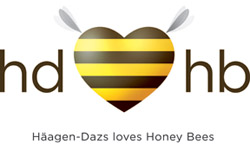
This bee sculpture, the work of Donna Billick of Davis, is one of the highlights of the Häagen-Dazs Honey Bee Haven. Wells Fargo Bank provided the funding for the sculpture and is sponsoring the grand opening celebration. Click to enlarge. (Photo by Kathy Keatley Garvey)
Grand Opening Celebration of Häagen-Dazs Honey Bee Haven
Catch the Buzz on Saturday, Sept. 11: Garden Tours, Speakers, Hands-On Demonstrations, Ice Cream
DAVIS—Garden tours, hands-on demonstrations, educational speakers and children’s activities will mark the grand opening celebration of the Häagen-Dazs Honey Bee Haven, set from 10 a.m. to 2 p.m., Saturday, Sept. 11 at the Harry H. Laidlaw Jr. Honey Bee Research Facility, Bee Biology Road, University of California, Davis.
The haven, a half-acre bee friendly garden planted last fall next to the research facility, is marking its first year of growth, said bee biology program coordinator Lynn Kimsey, professor of entomology at UC Davis and director of the Bohart Museum of Entomology.
The key goals of the garden are to provide bees with a year-around food source for the Laidlaw Facility bees, to raise public awareness about the plight of honey bees, and to encourage visitors to plant bee-friendly gardens of their own.
“We expect the honey bee haven to become a campus destination,” Kimsey said. “This is a year-around food source for bees and other pollinators and an opportunity for visitors to learn more about the plight of bees and what to plant in their own gardens to help them survive.”
“This garden is a living laboratory to educate, inspire and engage people of all ages in the serious work of helping to save honey bees,” said Dori Bailey, director of Haagen-Dazs Consumer Communications. “We hope the Häagen-Dazs Honey Bee Haven not only offers bees and other pollinators a place to thrive, but that it contributes to finding answers that enable us to be better stewards of these tiny pollinators.”
True to its mission, the half-acre bee garden has drawn pollinators from the Laidlaw facility’s 60 hives, each populated with some 60,000 honey bees. Other pollinators include bumble bees, butterflies, dragonflies, sweat bees and carpenter bees. Native pollinator specialist Robbin Thorp, emeritus professor of entomology at UC Davis, has identified more than 50 species of bees alone in two years of monitoring the grounds, as they changed from an open field to a planted garden.
Art created by students and the community in the UC Davis Art/Science Fusion Program, founded and directed by UC Davis entomologist-artist Diane Ullman and artist Donna Billick, will be permanently displayed at the garden.
Billick created a large bee sculpture for a pedestal beneath an almond tree. Wells Fargo Bank funded the bee sculpture and is the main sponsor of the grand opening celebration. The entrance features two bee-hive columns, one sculpture painted to depict the work that bees do inside the hive and the other, the work outside the hive.
Speakers will address the crowd beginning at 10:30 a.m. Neal Van Alfen, dean of the UC Davis College of Agricultural and Environmental Sciences, and entomology professor Lynn Kimsey, director of the Bohart Museum of Entomology, will welcome the crowd.
Other speakers:
11:15 a.m.: Cooperative Extension apiculturist Eric Mussen of UC Davis, “Honey Bee Decline”
11:45 a.m.: Garden co-designer Ann Baker of Sausalito, “Designing the Garden”
12:15 p.m.: Melissa “Missy” Borel, program manager of the California Center for Urban Horticulture, UC Davis, “Bee Friendly Plants”
12:45 p.m.: Scientists-artists Diane Ullman and Donna Billick of the UC Davis Art/Science Fusion Program, which created permanent art work in the garden. Billick created the 6-foot-long “Miss Bee Haven” bee sculpture, funded by Wells Fargo
1:15 p.m.: Native pollinator specialist Neal Williams of UC Davis, “Pollinator Eco-Services and the Role of Bees in Sustainable Food Production”
A children’s activity center, coordinated by Tabatha Yang, education and outreach coordinator of the Bohart Museum of Entomology, will include arts and crafts, including button-making, face-painting and flower crafting. A “buzz kazoo” is also in the works.
 |
A view of the Haagen-Dazs Honey Bee Haven. The Sept. 11th grand opening will be sponsored by Wells Fargo. (Photo by Kathy Keatley Garvey) |
Among others scheduled to participate at the various stations throughout the garden to converse with visitors: native pollinator specialist Robbin Thorp; bee breeder-geneticist Susan Cobey; beekeeper and staff research associate Elizabeth Frost; Ellen Zagory, director of horticulture for the UC Davis Arboretum; members of the winning design team (landscape architects Donald Sibbett and Ann F. Baker, interpretative planner Jessica Brainard and exhibit designer Chika Kurotaki); graduate student Emily Bzdyk; and members of the Neal Williams’ lab.
Complimentary Häagen-Dazs ice cream will be offered at the opening, as will samples of Gimbal’s Fine Candies from its honey lovers’ line. Gimbal’s, of San Francisco, is donating 5 percent from the sale of its candy to UC Davis honey bee research.
Also at the grand opening, food will be available for purchase, as will “bee” t-shirts from graduate and undergraduate students at UC Davis. Visitors will be invited to participate in drawings for posters, honey and other items.
Honey bees pollinate more than 100 different U.S. agricultural crops, valued at $15 billion. However, the nation’s beekeepers have reported losing from one-third to all of their bees due to a mysterious phenomenon known as colony collapse disorder (CCD) that surfaced in 2006. CCD is worsening, according to Mussen.
In response to the declining bee population, the Häagen-Dazs brand launched the "Häagen-Dazs Loves Honey Bees" campaign in February 2008, committing a total $250,000 donation for bee research to UC Davis and Pennsylvania State University, and redoubled its efforts in 2009 with a second $250,000 donation, bringing the brand’s total donation for honey bee research to a half million dollars. It also formed a scientific advisory Bee Board, created an educational Web site and introduced the new Vanilla Honey Bee ice cream flavor. Bees are crucial to nearly 50 percent of their all-natural flavors.
The garden design competition, funded by Häagen-Dazs and coordinated by the Department of Entomology and California Center for Urban Horticulture at UC Davis, drew submissions from throughout the world. A Sausalito-based team won the competition with a series of interconnected gardens with such names as “Honeycomb Hideout,” “Nectar Nook” and “Pollinator Patch.”
The design team zeroed in on sustainability and visitor experience. The four interconnected gardens, “Honeycomb Hideout,” “Nectar Nook,” “Pollinator Patch” and “My Backyard” form the “physical and interpretive framework” for the honey bee haven design. A series of trails connect the gardens.
“Incorporated into each of the four sections are gathering spaces that serve as orientation points for guided tours, facilitated programs and ‘chat time’ with beekeepers and entomologists,” the team explained. Identification labels will help visitors identify select what they can plant in their own yards.
Judges scored the designs on diversity (the winning design has 40 different plants), bloom balance, vision, generational learning, cost feasibility and attention to detail. “Judges also declared the team's design as the best at adhering to the River Friendly Landscaping guideline for our area,” said Borel, who coordinated the design competition.
Cagwin and Dorward Landscape Contractors, a Northern California company, installed the garden. Joining Wells Fargo as a sponsor is Annie's Homegrown, maker of Honey Bunny Grahams.
More information on the grand opening is available from event coordinator Chris Akins at (530) 752-2120 or crakins@ucdavis.edu.
Schedule10:30 a.m. Neal Van Alfen, dean of the UC Davis College of Agricultural and Environmental Sciences, and entomology professor Lynn Kimsey, director of the Bohart Museum of Entomology, will welcome the crowd. Speakers at the podium will include: Garden Tours: |
(Editor's Note: This is a free event, open to the public. No reservations are required)
Related links:
More than 50 Bee Species Found in Haven: Robbin Thorp
Artist-Scientist Donna Billick Creates Giant Bee Sculpture
Thinking Outside the Box: How the Beehive Columns Came to 'Bee'
Blending Art With Science: UC Davis Art/Science Fusion Program (See More Photos)
Häagen-Dazs Educational Website
Eric Mussen on Colony Collapse Disorder (Video)
Directions
Winning design:
Sausalito team plan (PDF, 21 pages)
Sponsors of grand opening celebration
 |
 |
 |